It became somewhat (our family isn’t very consistent) of a tradition to buy a new puzzle when all the kids came home for the holiday. It would be set up so anyone could work on it whenever they felt like it. Last Christmas we received a 2000 piece puzzle from our daughter, but it did not get opened until Mother’s Day. We’ve never put together a puzzle with that many pieces! I decided to set it up in our screened pavilion so I could enjoy the sounds of spring and the comfortable temperatures.
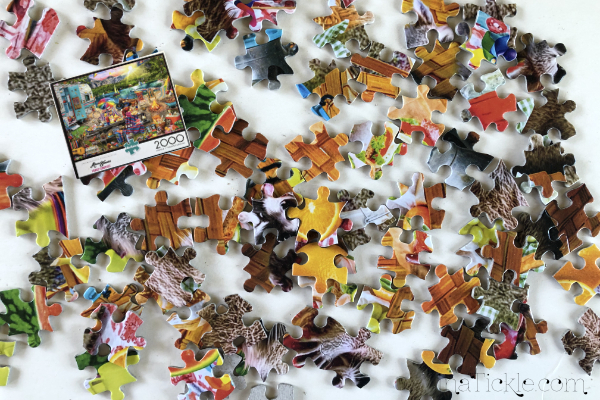
Once in a while someone would join me but I put most of the puzzle together over the next three weeks (in between many other activities). As I worked on it, my thoughts turned to the ways puzzles can help with creativity.
One way is to notice details of the shapes. Maybe there are other (more complicated) ways of starting a puzzle, but we always sort through the pieces only looking for those with a straight edge, the outside pieces of the puzzle. Of course, no matter how closely you think you look, there are always those elusive outside “missing” pieces, especially in puzzles with over 1000 parts. Once the edges are found (or most of them anyway) you can begin to put the frame of the puzzle together. Some people like to put puzzles together without looking at the picture on the box- not me! I want to know what I am looking for, but even then, if the puzzle has multiple areas of similar colors on the edges, it isn’t easy. Even with the photo to look at, each little piece does not have much detail to necessarily figure out what it is a part of.
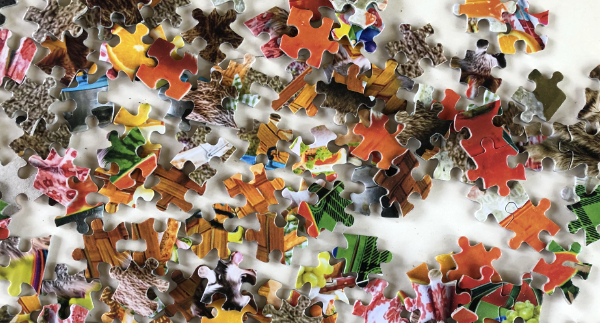
The pieces in the photo above are from the finished corner with the picnic basket below (disclosure: the photo of the pieces was taken after that corner was taken apart!) If each section of the puzzle pieces was bagged together, it would be easy to put together. But when these few pieces are mixed up with all 2000 pieces, it’s a different story.
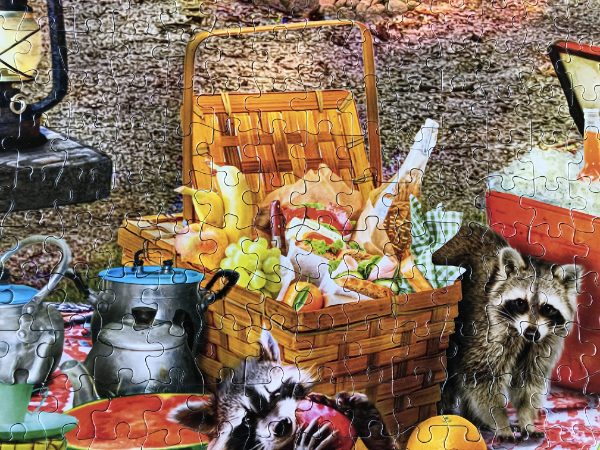
After the edges are completed, I generally start sorting out the pieces according to basic colors, the reds, greens, blues, yellows, etc. I like to use cookie sheets for my sorting trays. They are easy to stack and move around. After sorting it’s easier to focus on unique parts of the image and begin looking for those pieces that look similar. When I spend time looking for tiny details on pieces, my mind is constantly jumping back and forth from the puzzle pieces to what the “big” picture looks like. After doing that a while, a puzzle piece that made no sense will all of a sudden jump out and my brain knows exactly where it should go- even in an area where I wasn’t focused. I liken it to playing memory match games with the kids when they were little. Good training for the brain!
Of course each person will have their own process of putting puzzles together. My husband likes to look for shapes that will fill particular places, whereas I am mainly focused on the colors and details. I don’t usually look for a specific shape until I am down to the last odd pieces to put in.
When I am creating art, I usually have some kind of picture in my head of what I want to do. But the process of reaching that goal requires mentally breaking down the steps and details to figure out what to do next- much like jumping back and forth between the small puzzle pieces and the finished picture on the box. No matter what type of creative endeavor, that process is required. For instance, working with watercolor paint is an opposite process of working with acrylics. Watercolor painting starts with the light colors and then darker colors because of the transparency of the medium. Light colors won’t show on top of dark colors and if you want white, you leave the paper unpainted in those areas. Your brain has to be trained to think through the little details (pieces) to get to the finished goal.
Once the pieces of the puzzle with distinct characteristics are put together, I end up with gaping holes of very similar colors and and not much detail. As you can see in the photo below, I am missing lots of green vegetation, brown wood with lots of shadows, and tan colored pebbles on the ground.
The piles of green pieces all look pretty much the same until you look closely. You begin to notice the subtle color differences between the greens and whether they are in shadow or sunlight. Then some pieces begin to look more focused than others giving you an indication of where they might fit in the depth of field of the picture. It’s seeing those tiny differences in the pieces and how they fit into the whole that improve your brain function.
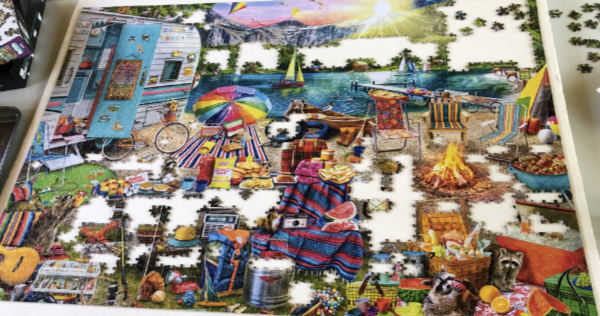
For many people, putting together puzzles is a relaxing activity, and good for stress relief. My youngest grandson (age 8) helped me several times with this puzzle and in the middle of putting a piece in place he said, “There is just something so satisfying about putting a piece into it’s right spot!”
So finally the puzzle is completed, and you just sit and look at the masterpiece you’ve created!
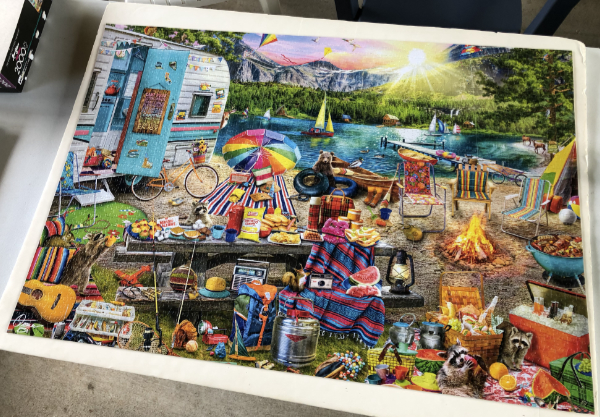
And then after a few days, it’s time to break apart the puzzle and put it back into its box, thankful for the hours of peace and joy spent solving (creating) it.
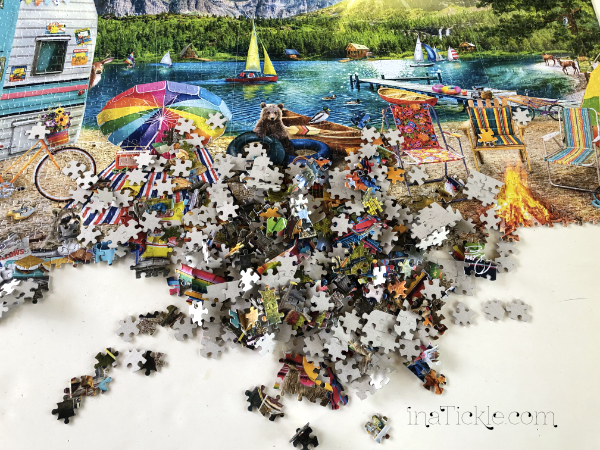
A favorite local thrift store received a huge donation of used puzzles and I bought a few. This time I started working on a puzzle with vegetables and fruits- looked like it would be a quick, easy one to do and it only had 1000 pieces. Do you know how many close shades of reds and shades of greens and shades of yellow were in this “easy” puzzle? Again I had to work on training my eyes to see the tiny differences.
I have an app on my phone that an art teacher recommends to his students to help train their eyes to see the blends colors can make. The first blend puzzles are easy, but then they get tricky. It is amazing though how much your eyes can begin to see blends, shades, and tints of colors. If you are interested in improving your creative skills in use of color, it is called Blendoku.
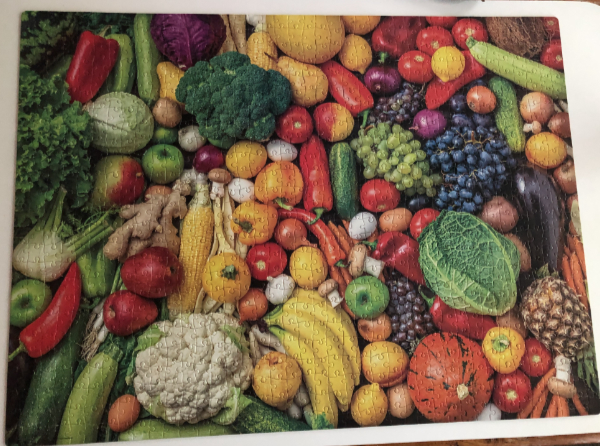
The next puzzle was a much harder one. It was a pile of crayons. The box was small and did not have a full image of the finished puzzle. So this one was a challenge for me just putting together the outer edges- I did not know what corners went where! I did discover while sorting through the pieces that some of them had a shiny coating on all of the piece or partial pieces. That seemed strange until I realized that several of the completed crayons were shiny and that gave me staring points for putting the inside of the puzzle together. Again- lots of detail and subtle changes of colors to focus on!
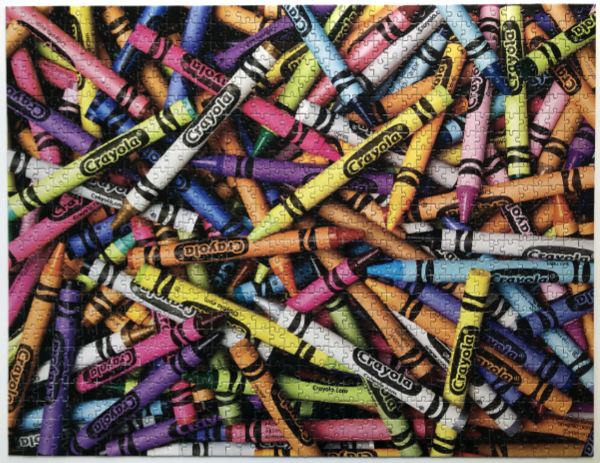
After pondering how puzzles were good for developing your creativity, I looked online to see if I was right. Well, I found several articles about the benefits for brain improvement and helping you live longer! So, instead of passively sitting in front of the TV, pull out a puzzle and help improve your brain!
“Puzzles are also good for the brain. Studies have shown that doing jigsaw puzzles can improve cognition and visual-spatial reasoning. The act of putting the pieces of a puzzle together requires concentration and improves short-term memory and problem solving. Using the puzzle as an exercise of the mind can spark imagination and increase both your creativity and productivity.” (Jill Riley, M.S.N., senior clinical operations associate in the Michael E. DeBakey Department of Surgery at Baylor College of Medicine
https://blogs.bcm.edu/2020/10/29/a-perfect-match-the-health-benefits-of-jigsaw-puzzles/)
